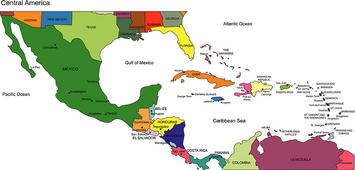
Increasingly, the debate over plummeting world birth rates is shifting to the developing world. This includes Latin America where on the whole rates are dropping quickly from 5.98 children per woman in 1960 to 2.20 children per woman in 2010.
Yet these aggregate numbers do not reflect the variation in birthrates between various Latin American countries. Even as countries such as Brazil, Argentina, and Mexico head to rates at or even below replacement rates, there remain extreme examples of both higher and lower rates throughout the region. The most extreme variation can be found in Cuba and Guatemala which respectively have the lowest and highest fertility rates in Latin America.
Cuba is estimated to have a current fertility rate of 1.47 children per woman, well below replacement level of 2.1 children per woman. This extremely low rate is not new to Cuba; rather, it reflects changing population dynamics that have been developing since the rise of communism on the island. The effects of low fertility have already begun to manifest themselves in the population of Cuba. For example, between 2005 and 2008, Cuba’s population actually decreased. Although it did increase slightly again from 2008 to 2011, the trend of decreasing population is projected to continue as time goes on.
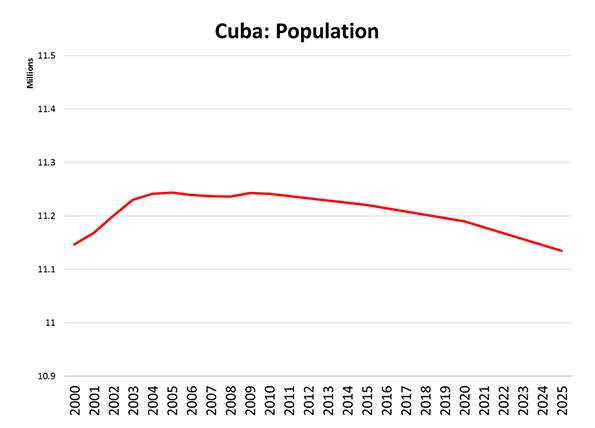
Source: Oficina Nacional Estadística de Cuba
Cuba’s population by 2025 is supposed to be lower than its population 25 years earlier in 2000 (11,146,203 people in 2000 and only 11,134685 people 2025). Although this decrease of 110,000 people does not seem to be too much of an issue, it will have a severe effect on the country’s workforce and rapid aging. This rapid aging may also reflect the ubiquity of Cuba’s medical care system, which may allow for much of its population to live longer and healthier lives. Cuba’s life expectancy, 78.96 years at the time of birth, is much greater than other countries such as Guatemala and Bolivia, whose life expectancies are 70.83 and 66.27 respectively.
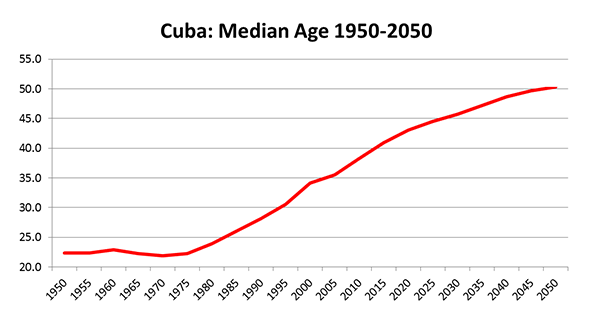
Source: Oficina Nacional Estadística de Cuba
In 100 years, the median age of the population of Cuba is predicted to more than double from its 1950 rate. Children compose a smaller and smaller proportion of the population while the adult population continues to grow.
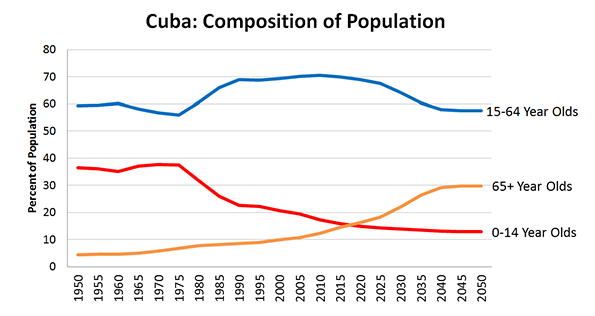
Source: Comisión Económica para América Latina y el Caribe (CEPAL) División de Población (CELADE)
In this sense Cuba, although a relatively poor country with a Gross National Income per capita of $5,460 in 2008 has demographics more widely associated with far more affluent countries such as Japan, Germany, Italy and Spain. Sometime between 2015 and 2020, Cuban men and women aged 65 and older will outnumber the amount of children in the country, something that has never happened before. The mid 1960s to 1980s saw a major decrease in fertility rates in Cuba, which is shown in the graph above. From 1960 to about 1975 the percentage of children in the population was steady, but then it plummeted dramatically until the mid-1990s, which also saw a massive rise in the share of adults.
At the other Latin extreme stands Guatemala, estimated to nearly double its population by 2050, from 14,740,000 in 2011 to 27,444,000 in 2050 (a growth of 86.2%). This is a staggering statistic considering the many issues already facing Guatemala. Guatemala has the highest fertility rate of any Latin American, beating out some of the poorest countries in the region. Its current fertility rate is 3.98 children per woman. This is nearly double the replacement level, which is quite divergent from Cuba’s fertility rate.
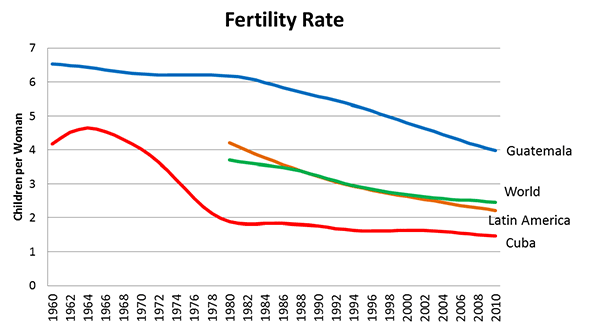
Source: World Bank
Guatemala’s fertility rate has been steadily declining since 1960; it still has an extremely high fertility rate that is nearly double replacement level. This means that its population will continue to increase due to a large number of births; however, that is not the only reason for population growth in Guatemala. Like the general trend the world is experiencing, life expectancy in Guatemala is continuing to increase and will only increase more as time goes on.
As women have on average 3.98 children during their lifetime and the entire population begins to live longer and longer, a major increase in population will occur. Like Cubans, Guatemalans now have longer life expectancies than the world average.
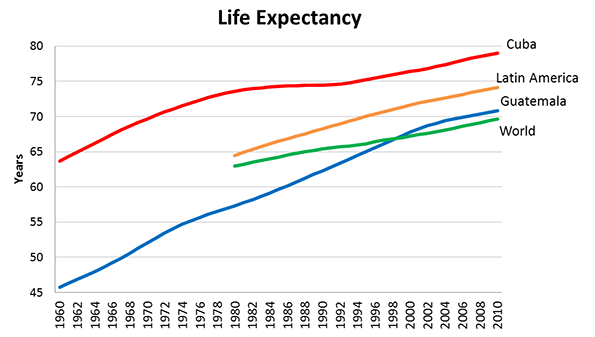
Source: World Bank
Guatemala reflects a strange mix of underdevelopment and modernism, which together could drive the major population increase over the next 40 years. The underdevelopment keeps the fertility rate high, while the modernism is driving life expectancy upwards. While the fertility rate is decreasing, it will take a very long time for it drop below replacement level. Similarly, life expectancy will continue to increase until it begins to level off many decades into the future. Not only will its population be affected, but the structure of the population will change with time too.
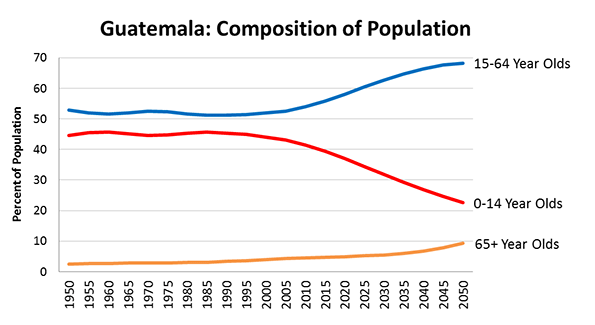
Source: Comisión Económica para América Latina y el Caribe (CEPAL) División de Población (CELADE)
Ultimately, Guatemala has the healthier population trend. Cuba’s decreasing population will begin to pose major problems. Not only will the population continue to decrease, but the population will also continue to age. Causing significant strain on a government that already has some of the highest rates of social safety net spending. Looking at the average growth rates for Cuba and Guatemala, it seems that Guatemala may be on a healthier trajectory when it comes to population.
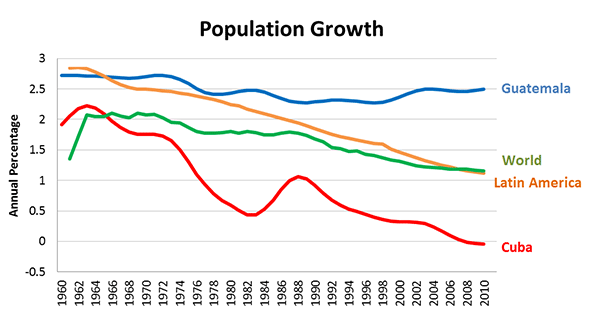
Source: World Bank
This is also expressed in the representation of birth and death rates per 1,000 people in the country. Guatemala has a general decrease of both factors over time, which is a fairly common trend in developing countries; however, Cuba has quite erratic behavior in its population’s manifestation of birth and death rates per 1,000 people.
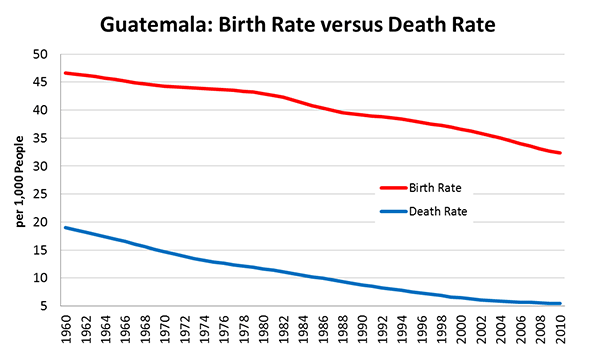
Source: World Bank
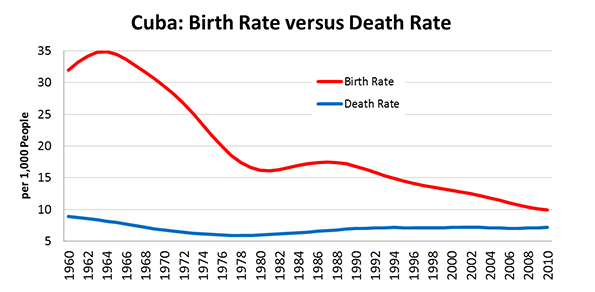
Source: World Bank
The 1959 revolution in Cuba caused major shocks to the population both in terms of births and deaths. Immediately following the revolution in 1959, the death rate decreased, while the birth rate actually increased for a few years, only to drop drastically over the next 15 years or so. Cuba’s exceptional government structure – with its welfare state and poor economy – has caused a strange population phenomenon that does not occur in Latin Countries. Guatemala, in contrast, reflects a strange confluence of underdevelopment and modernism. It seems likely that Cuba will soon face a major fiscal and economic fallout from too low fertility while Guatemala will have a population explosion, with a whole different set of challenges.
Population and its dynamics fuel a constant policy debate in every country throughout the world. In Latin America, these divergent fertility rates will not only affect the region but also the world as a whole. Guatemala’s population trajectory could mean increased emigration from the country to the Northern Hemisphere, while Cuba’s population trajectory could mean a collapse of the system and a restructuring of the entire Cuban life. Overall, Latin America has many significant challenges that other regions in the world do not face, and it seems that the divergent population trajectories of different countries in Latin America will ultimately drive major social, political, and economic changes in the region.
Sam Schleier is a senior Peace Studies major and Latin American Studies minor at Chapman University in Orange, CA. He is originally from Phoenix, AZ.
Central America map by Bigstockphoto.com.












